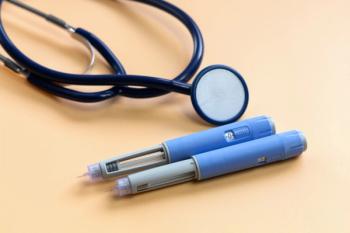
Pharmacy Practice in Focus: Health Systems
- May 2019
- Volume 8
- Issue 3
Pharmacists Are Integral to Diabetes Care
They are accessible to patients, help identify risk factors, provide lifestyle education, and offer medication management.
Diabetes affects about 30.3 million individuals in the United States, according to the CDC’s most recent estimate.1,2 In addition, the CDC estimates that among people aged 18 and older, about 84.1 million have prediabetes, a condition characterized by blood sugar levels higher than normal but not high enough for a diabetes diagnosis (eg, fasting plasma glucose, 100-125 mg/dL; glycated hemoglobin [A1C], 5.7%-6.4%).1,2 Individuals with prediabetes are also more prone to heart disease, stroke, and type 2 diabetes (T2D).
Diabetes, a group of diseases characterized by high blood sugar, is the seventh-leading cause of death in the United States, and complications from uncontrolled diabetes can also cause gum and kidney disease, vision loss, and peripheral diabetic neuropathy, potentially resulting in foot problems.2 Comorbid conditions, such as heart disease and stroke, are also more common in people with diabetes.
The American Diabetes Association (ADA) recommends a team-based approach to managing a patient’s diabetes.3 Findings from many studies back up the contributions that clinical pharmacists make as part of
the interdisciplinary team treating patients with diabetes.4-7
In particular, the Asheville Project highlighted the effectiveness of pharmacists in diabetes management. After 1 year, participants had significantly reduced their A1C and low-density lipoprotein cholesterol levels, a reduction that was sustained 5 years later.4 To piggyback on the success of the Asheville Project, the American Pharmacists Association (APhA) Foundation established the Diabetes 10-City Challenge as a program for communities and employers to fight diabetes and manage health care costs.5
COST BENEFIT
The results of a US Department of Veterans Affairs (VA) study found that getting patients with T2D to their A1C goal cost between $115 and $164, which is a small expense with a big payoff, considering that the estimated 3-years savings per patient to the VA hospital was $9000.8 The Asheville Project and Diabetes 10-City Challenge have also shown great cost benefit, with the latter saving about $918 per employee in health care costs during the first year of implementation.4,5 There are other cost benefits when metrics such as A1C, blood pressure (BP), and low-density lipoprotein levels improve.7
HOW PHARMACISTS CAN CONTRIBUTE
Accessibility
Despite heavy workloads and short staffing, pharmacists are available to answer patient questions, for counseling, and to dispense medications. Because of these frequent patient encounters, pharmacists are likely to see many people with prediabetes and can be instrumental in the education and screening process.
Identifying Risk Factors
As part of their accessibility in clinics, in the community, and during hospital rounds, pharmacists can help with risk-factor assessment, whether it is asking about family history, physical inactivity, and weight, and work with health care providers to obtain BP and cholesterol panels.
Lifestyle Education
Not only can pharmacists effectively counsel on specific diabetes medications, they can also educate patients on lifestyle modifications and other facets of diabetes management.6,9 For example, the ADA emphasized in its 2019 guidelines how technology is continually expanding and that self-monitoring of blood glucose is extremely important, especially among patients on insulin therapy.3 Pharmacists can help patients set up their glucometers, explain to them the importance of not having expired test strips, and help them develop a log to monitor their blood glucose.
Counseling on diet, exercise, and smoking cessation and helping select appropriate therapy for each individual can benefit clinics and community settings.6 And following up with these patients regularly can help eliminate or mitigate the adverse effects (AEs) caused by uncontrolled diabetes.
Medication Management
For patients with a new diagnosis, administering insulin, managing their diet and medications, and taking their blood sugar can be an overwhelming process. Strategies for staffing should be in place to ensure that pharmacists are available to assist patients and that no pharmacist is too busy filling prescriptions to answer questions and provide the necessary care and education for patients with diabetes. Medication nonadherence is a common issue, because of the complexity and lifelong nature of therapy and should frequently be discussed at visits.6 Patients on insulin need to be counseled on insulin storage, the signs and symptoms of hyper- or hypoglycemia, technique, and what to do in case of an event. Routine counseling on AEs, drug interactions, and duplicate therapy should also be a mainstay of care.
Monitoring
A large part of managing the adherence of patients and the effectiveness of treatment is monitoring. Daily logs for patients on insulin are important, as is measuring their A1C and other markers that can contribute to comorbid conditions, such as cholesterol and high BP. In clinics where pharmacists have collaborative practice agreements, they can work with a team to obtain and utilize these numbers. Clinical pharmacists in hospitals can discuss this on rounds, and community pharmacists can educate patients about the importance of showing up to their follow-up visits.
Prevention Screening
Not every diabetes case is textbook. Some cases are not revealed until a patient presents in an emergency state. A routine screening at a health clinic or pharmacy may be an efficient way to identify patients with a potential diagnosis among those with risk factors. A blood glucose draw, a referral to a physician, or a risk-factor assessment test are all methods by which this can be done. Social barriers should also be assessed when screening to determine if patients have the financial stability to afford medications, to ensure that they have healthy food available, and to see if they have community support.
Quality Improvement
Along with costs, many government programs focus on value-based care and outcomes as conditions. Because value-based care, along with reimbursement, is so important to patient care, clinical pharmacists can be a valuable resource in achieving quality and cost benchmarks.6,10
Transitions of Care
Reconciling medications through the discharge process and health care transitions ensures that duplicate therapy is eliminated and medications that were discontinued are not reordered. Pharmacists can follow patient care through physician visits, using clinical expertise to manage and monitor diabetes care plans, and educate on adherence, disease, and lifestyle.10
AVAILABLE RESOURCES
The National Diabetes Prevention Program (DPP) is a partnership of private and public organizations working together to build the infrastructure for the nationwide delivery of an evidence-based lifestyle program to delay or prevent the onset of T2D in adults with prediabetes.10 This program is based on the science of the DPP research study and several others, which found that making small behavioral changes helped people with prediabetes to lose 5% to 7% of their body weight and reduced their risk of developing T2D by 58%.10 Other resources for pharmacists include a certificate program set up through the APhA and becoming a certified diabetes educator.
CONCLUSION
The value added by having a pharmacist on the care team, whether in the clinic or in a community pharmacy, is significant. It is important for those leading diabetes programs—in a clinic, community, or hospital—to move beyond the traditional product focus of pharmacy services and recognize and integrate pharmacists into this important role.
With the prevalence of diabetes rising in the United States, increasing patient access to health care providers who can facilitate improved diabetes self-management is important. Pharmacists are a significant resource, and adding them to diabetes care teams can improve the outcomes of patients with diabetes, as well as prevent complications and reduce costs.
There is often a limited understanding of the services and value that pharmacists provide. It is important to take the time to educate providers and staff members about the certifications, educational background, and postgraduate training that allow pharmacists to operate in their unique role. This education, along with cost-analysis, could be paramount in creating new positions for pharmacists in clinics and other settings.
Joanna Lewis, PharmD, MBA, has worked in a variety of practice settings, most recently as a coordinator at Duke University Hospital in Durham, North Carolina.
REFERENCES
- CDC. National Diabetes Statistics Report. cdc.gov/diabetes/data/statistics/statistics-report.html. Updated February 24, 2018. Accessed March 12, 2019.
- American Diabetes Association. Statistics about diabetes. diabetes.org/diabetes-basics/statistics/. Updated March 22, 2018. Accessed March 12, 2019.
- American Diabetes Association. Standards of medical care for patients with diabetes mellitus. Diabetes Care. 2003;26(Suppl. 1):S33—S50.
- Cranor CW, Bunting BA, Christensen, DB. The Asheville Project: long-term clinical and economic outcomes of a community pharmacy diabetes care program. J Am Pharm Assoc (Wash). 2003;43(2):173-184.
- Fera T, Bluml BM, Ellis WM. Diabetes Ten City Challenge: final economic and clinical results. J Am Pharm Assoc. 2009;49(3):383-391. doi: 10.1331/JAPhA.2009.09015.
- Misita C. Clinical pharmacists in outpatient diabetes care: essential members of the multidisciplinary team. Clinical Diabetes 2013;31(4):162-165.
- Ragucci KR, Fermo JD, Wessell AM, Chumney AC. Effectiveness of pharmacist-administered diabetes mellitus education and management services. Pharmcotherapy. 2005;25(12):1809-1816.
- Choe HM, Mitrovich S, Dubay D, Hayward RA, Krein SL, Vijan S. Proactive case management of high-risk patients with type 2 diabetes mellitus by a clinical pharmacist: a randomized controlled trial. Am J Manag Care. 2005;11:253-260.
- Manganelli, J. The role of clinical pharmacist in achieving clinical and quality outcomes in diabetes management. Am J Manag Care. 2016;22(4 Spec No.):SP128-SP129.
- CDC. National diabetes prevention program. cdc.gov/diabetes/prevention/index.html. Updated August 10, 2018. Accessed March 14, 2019.
Articles in this issue
over 6 years ago
How Does a Pharmacy Train Staff to Handle HDs?over 6 years ago
HIV Treatments and Guidelines Offer More Optionsover 6 years ago
SBRT Improves Options for Prostate Cancerover 6 years ago
Carfilzomib Shows Potential in Myelomaover 6 years ago
Get PrEPared for HIV ProphylaxisNewsletter
Stay informed on drug updates, treatment guidelines, and pharmacy practice trends—subscribe to Pharmacy Times for weekly clinical insights.


















































































































































































































